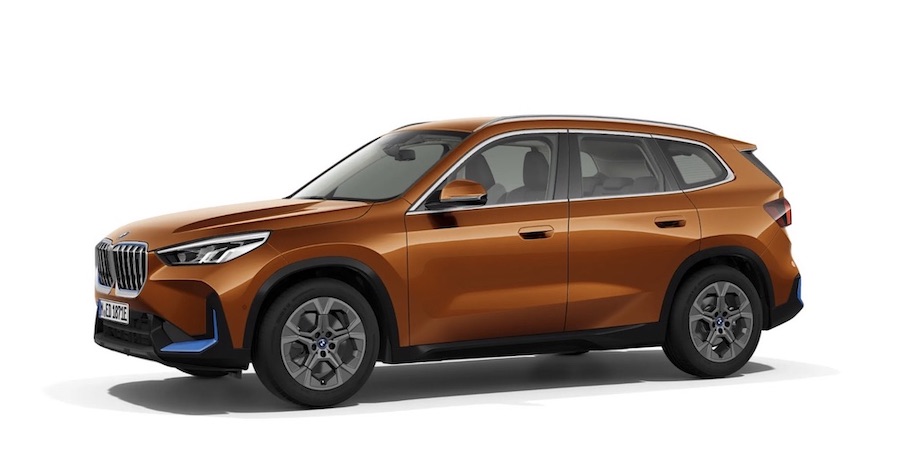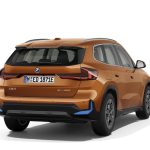Electric Cars: The Basics
For those of you new to zero-emission electric driving, we recommend a read of the following articles:
Sign up to the newsletter
The BMW iX1 Electric SUV
BMW (Bayerische Motoren Werke AG), is a leading global automotive manufacturer headquartered in Munich, Germany. BMW is well known for its portfolio of luxury vehicles, to include the famed Rolls-Royce luxury cars. The group manufacturers a number of cars under its BMW brand, to include battery-electric vehicles (BEVs) and plug-in hybrid electric vehicles (PHEVs). The BMW i3 EV is an excellent example of a successful pure electric car. The company currently has the following portfolio of battery-electric vehicles (BEVs):
- All-electric BMW iX3
- All-electric BMW iX1
- All-electric BMW iX2
- All-Electric BMW i5
- All-Electric BMW i7
- All-electric BMW iX
- All-electric BMW i4
- All-electric BMW i3
The BMW iX1 is the latest electric vehicle (EV) to join the portfolio of pure electric SUVs offered by BMW. Like the conventional internal combustion engine (ICE) X1, the iX1 offers a more affordable entry into the world of BMW premium SUVs.
So far, the technical information released by the automotive manufacturer is limited, but we expect more information to become available closer to the time of sale. The EV offers all-wheel drive (AWD) as standard, with dual motors, one motor at the front axle and the other at the rear.
The BMW iX1 family SUV is available in one EV battery size: 64.7 kWh (usable capacity), with a claimed pure electric range up to 438 km. The EV battery size and zero-emission electric range is similar to many of the more recent introductions of pure electric cars i.e. there is a trend of increasing EV battery size and longer zero-emission electric range.
Of course, the real-world EV range will be lower, impacted by a number of factors, to include: speed, driving profile, regen braking profile, weather conditions, road conditions, tyre size, onboard services used, payload and more. Expect a real-world electric range closer to 370 km. Useful for both short city commutes and longer motorway journeys!
As is the case with electric cars, the BMW iX1 has an onboard recuperation system that converts the kinetic energy during braking into electricity, further enhancing the efficiency of the electric vehicle and e-range. This is also known as regenerative braking. It does take some getting used to, but not long!
We at e-zoomed recommend a ‘topping up’ approach to charging an electric car. This way, there is always range readily available and moreover, a topping up approach reduces the amount of time required to charge. Regular charging is also beneficial for the long-term maintenance of the EV battery. BMW offers a 8 years or 160,000 km, which is fast becoming the industry standard for EVs.
The electric vehicle (EV) can be DC charged up to 130 kW and can achieve a 0%-80% in 29 minutes. The e-SUV incorporate a 11 kW (3-phase) onboard charger, which can fully charge the EV in 5 hours. There is also an option to upgrade to a 22 kW (3-phase) onboard charger.
However, given that most homes in India are restricted to single-phase power supply, it would not be necessary to upgrade to 22 kW. BMW has yet to give details for single-phase charging, but of course it will take longer compared to 3-phase EV charging.
The BMW iX1 electric SUV can achieve 0-100 kmph in 5.7 seconds. The vehicle delivers a maximum power up to 313 hp and 494 Nm torque. The top speed of the e-SUV is 180 kmph. Like other pure electric cars, the BMW iX1 also benefits from instant torque.
The BMW iX1 electric SUV is not available in India. Bottom-line, electric driving is good for the environment and for the wallet.
| PROS | CONS |
|---|---|
| Decent pure electric range | Only available in one EV battery size |
| DC charging up to 130 kW. Three-phase (11 kW) onboard charger as standard | Not built on a dedicated EV platform |
| All-wheel drive (AWD) as standard | Cheaper alternatives available |
The All-Electric BMW iX1 SUV (credit: BMW)
| At A Glance | |
|---|---|
| EV Type: | Battery-Electric Vehicle (BEV) |
| Vehicle Type: | SUV |
| Engine: | Electric |
| Available In India: | No |
| Trims (1 Option) |
|---|
| BMW iX1 (from ₹ N/A) |
| EV Battery & Emissions | |
|---|---|
| EV Battery Type: | Lithium-ion |
| EV Battery Capacity: | Available in one battery size: 64.7 kWh |
| Charging: | 130 kW DC charging (10%-80%: 29 mins). Onboard charger 11 kW AC (0%-100%: 5 hrs) |
| Charge Port: | Type 2 |
| EV Cable Type: | Type 2 |
| Tailpipe Emissions: | 0g (CO2/km) |
| Warranty: | 8 years or 160,000 km |
| Charging Times (Overview) | |
|---|---|
| Slow charging AC (3 kW – 3.6 kW): | 6 – 12 hours (dependent on size of EV battery & SOC) |
| Fast charging AC (7 kW – 22 kW): | 3 – 8 hours (dependent on size of EV battery & SoC) |
| Rapid charging AC (43 kW): | 0-80%: 20 mins to 60 mins (dependent on size of EV battery & SoC) |
| Rapid charging DC (50 kW+): | 0-80%: 20 mins to 60 mins (dependent on size of EV battery & SoC) |
| Ultra rapid charging DC (150 kW+): | 0-80% : 20 mins to 40 mins (dependent on size of EV battery & SoC) |
| Tesla Supercharger (120 kW – 250 kW): | 0-80%: up to 25 mins (dependent on size of EV battery & SoC) |
- Note 1: SoC: state of charge
| Dimensions | |
|---|---|
| Height (mm): | 1616 |
| Width (mm): | 1845 |
| Length (mm): | 4500 |
| Wheelbase (mm): | 2692 |
| Turning Circle (m): | 11.9 |
| Boot Space (L): | 490 |
| BMW iX1 | |
|---|---|
| EV Battery Capacity: | 64.7 kWh |
| Pure Electric Range (WLTP): | 413 – 438 km |
| Electric Energy Consumption (km/kWh): | 18.4 – 17.3 |
| Charging: | 130 kW DC charging (10%-80%: 29 mins). Onboard charger 11 kW AC (0%-100%: 5 hrs) |
| Top Speed: | 180 km/h |
| 0-100 km/h: | 5.7 seconds |
| Drive: | All-wheel drive (AWD) |
| Electric Motor (kW): | 230 |
| Max Power (hp): | 313 |
| Torque (Nm): | 494 |
| Transmission: | Automatic |
| Seats: | 5 |
| Doors: | 5 |
| Unladen Weight-EU (kg): | N/A |
| Colours: | 7 |
| NCAP Safety Rating: | N/A |
BEVs Vs PHEVs: Which Is Better?
Both, battery-electric vehicles (BEVs) and plug-in hybrid electric vehicles (PHEVs) have significant advantages over conventional internal combustion engine (ICE) petrol and diesel vehicles. However, when BEVs and PHEVs are compared together, the narrative is not as black & white. Both types of electric vehicles (EVs) have pros and cons, and depending on the buyer circumstances, one type of EV will be more appropriate.
Plug-in hybrid electric cars have played an important role in encouraging drivers to migrate to electric driving. ‘Familiarity’ and ‘range security’ offered by plug-in hybrid vehicles, have been key attributes in propelling buyers to migrate to electric driving. A PHEV in many respects is very similar to driving a conventional petrol/ diesel car, except for the introduction of an electric mode, regenerative braking and EV charging.
As an example, the Land Rover Range Rover Evoque Plug-In Hybrid SUV, uses both, a petrol engine and an electric motor to propel the vehicle. The electric motor is driven by an onboard EV battery, which is charged via an external EV charging station. For those keen on ‘familiarity’, a PHEV, despite the addition of an electric motor, is very similar to driving a conventional petrol or diesel car.
The other impediment to migrating to EVs is range anxiety. In a PHEV there is no fear about an ’empty’ EV battery, as the vehicle can still be driven on the internal combustion engine (ICE). Bottom-line, for those in India keen to use an EV, but lack EV charging infrastructure and need to travel long distances on a regular basis, a plug-in hybrid electric car is more appropriate than a BEV.
Pure electric cars (BEVs) have come a long way over the past decade, since the introduction of the all-electric Nissan Leaf in 2010. In particular, in regards to increased EV range. Pure electric cars like the Tesla Model 3 can offer a range up to 360 miles (the first generation Leaf offered a range up to 73 miles). The Model 3 is not the only EV that can offer a long electric range. In fact, many of the recent EVs introduced have a range well over 200 miles on a full battery charge. This significant improvement in electric range has helped reduce the concern over range anxiety, enabling greater confidence in EVs.
Unlike PHEVs, pure electric cars are zero-tailpipe emission i.e. a BEV does not have a tailpipe and therefore does not pollute the air! The improvement in air quality, is one of the key advantages of choosing a BEV over a PHEV. The other key advantage is that a BEV is cheaper to drive and maintain, compared to a PHEV. This should come as no surprise as a BEV has only an electric motor/s, while a PHEV has an internal combustion engine, coupled with an electric motor. Put another way, a plug-in hybrid EV has many more moving parts and therefore more to maintain and repair overtime!
BEVs are well suited for businesses and families keen to improve local air quality and reduce the cost of driving. Of course, access to dedicated EV charging infrastructure at home and on the road is a prerequisite to owning a BEV!
While e-zoomed uses reasonable efforts to provide accurate and up-to-date information, some of the information provided is gathered from third parties and has not been independently verified by e-zoomed. While the information from the third party sources is believed to be reliable, no warranty, express or implied, is made by e-zoomed regarding the accuracy, adequacy, completeness, legality, reliability or usefulness of any information. This disclaimer applies to both isolated and aggregate uses of this information.

































